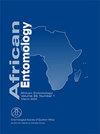Biological Control of Cactaceae in South Africa
IF 1.2
4区 农林科学
Q3 ENTOMOLOGY
引用次数: 11
Abstract
Cactaceae are among the most problematic invasive alien plants in South Africa, posing serious negative consequences to agriculture and natural ecosystems. Fortunately, South Africa has a long and successful history of controlling cactus weeds using biological control (biocontrol). This paper reviews all the biocontrol programmes against invasive alien Cactaceae in South Africa, focusing on the decade since the last review published in 2011, up to, and including 2020. Biocontrol programmes against 16 target weeds are summarised, all of which rely on either the galling mealybug, Hypogeococcus sp. (Pseudococcidae), or various species or intraspecific lineages of cochineal insects (Dactylopius spp., Dactylopiidae) as agents. New agents are being considered for the three target weed species, Opuntia elata Salm-Dyck, Opuntia megapotamica Arechav. and Trichocereus spachianus (Lem.) Riccob., while permission to release a new agent against Cylindropuntia pallida (Rose) F.M. Knuth has recently been granted. The biocontrol agent, Dactylopius opuntiae (Cockrell) ‘stricta’, which has been utilised for the successful control of Opuntia stricta Haw., has shown some promise as an agent against one of the worst cactus weeds in the country, the North Cape/Free State variety of Opuntia engelmannii Salm-Dyck. Post-release monitoring and recent observations of the status of control for the 11 other cactus weeds, all of which have well-established agents, are provided. Taxonomic uncertainties and misidentifications of both target weeds and agents has been a constraint to biocontrol efforts, but this has been partially overcome through the use of genetic techniques. Biocontrol is particularly successful in controlling cactus weeds compared to most other taxonomic groups, and it is likely that past successes can be repeated with new target weeds. Mass-rearing and redistribution of agents are essential to gain the maximum possible benefit from cactus biocontrol agents, and recent increases in mass-rearing outputs have been beneficial.南非仙人掌病的生物防治
仙人掌科是南非问题最严重的外来入侵植物之一,对农业和自然生态系统造成了严重的负面影响。幸运的是,南非使用生物控制(生物控制)控制仙人掌杂草有着悠久而成功的历史。本文综述了南非针对外来入侵仙人掌科的所有生物防治计划,重点介绍了自2011年发表上一篇综述以来的十年,直到2020年(包括2020年)。总结了针对16种目标杂草的生物防治方案,所有这些杂草都依赖于令人恼火的粉蚧、Hypogeococcus sp.(Pseudocockidae)或胭脂虫的各种物种或种内谱系(Dactylopius sp.、Dactylobidae)作为药剂。目前正在考虑为三种目标杂草物种——仙人掌Salm Dyck和巨型仙人掌Arechav——提供新的药剂。和Trichocereus spachianus(Lem.Riccob。,而最近已获准释放一种新的针对苍白圆柱仙人掌(Rose)F.M.Knuth的药剂。生物防治剂仙人掌(Cockrell)“stricta”已被用于成功防治仙人掌。,作为对抗该国最糟糕的仙人掌杂草之一,北开普省/自由州品种仙人掌(Opuntia engelmanii Salm Dyck)的药剂,已经显示出了一定的前景。提供了对其他11种仙人掌杂草的释放后监测和最近的控制状态观察,所有这些杂草都有成熟的药剂。目标杂草和药剂的分类不确定性和误认一直是生物防治工作的制约因素,但通过使用遗传技术,这一点已被部分克服。与大多数其他分类学类群相比,生物防治在控制仙人掌杂草方面尤其成功,而且过去的成功很可能会在新的目标杂草上重复。大规模饲养和药剂的重新分配对于从仙人掌生物防治剂中获得最大可能的利益至关重要,最近大规模饲养产量的增加是有益的。
本文章由计算机程序翻译,如有差异,请以英文原文为准。
求助全文
约1分钟内获得全文
求助全文
来源期刊

African Entomology
生物-昆虫学
CiteScore
2.00
自引率
0.00%
发文量
17
审稿时长
6-12 weeks
期刊介绍:
African Entomology (ISSN 1021-3589 – print / 2224-8854 – online) replaced the old Journal of the Entomological Society of Southern Africa in 1993. A single volume consisting of two issues (March and September) is published annually. The journal is indexed in all major abstracting journals
African Entomology is a peer reviewed scientific journal that publishes original research articles and short communications on all aspects of entomology, with an emphasis on the advancement of entomology on the African continent.
 求助内容:
求助内容: 应助结果提醒方式:
应助结果提醒方式:


